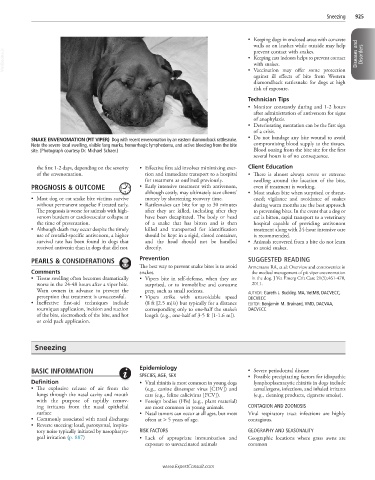Page 1843 - Cote clinical veterinary advisor dogs and cats 4th
P. 1843
Sneezing 925
• Keeping dogs in enclosed areas with concrete
walls or on leashes while outside may help
VetBooks.ir • Keeping cats indoors helps to prevent contact Diseases and Disorders
prevent contact with snakes.
with snakes.
• Vaccination may offer some protection
against ill effects of bite from Western
diamondback rattlesnake for dogs at high
risk of exposure.
Technician Tips
• Monitor constantly during and 1-2 hours
after administration of antivenom for signs
of anaphylaxis.
• Deteriorating mentation can be the first sign
of a crisis.
SNAKE ENVENOMATION (PIT VIPER) Dog with recent envenomation by an eastern diamondback rattlesnake. • Do not bandage any bite wound to avoid
Note the severe local swelling, visible fang marks, hemorrhagic lymphedema, and active bleeding from the bite compromising blood supply to the tissues.
site. (Photograph courtesy Dr. Michael Schaer.) Blood oozing from the bite site for the first
several hours is of no consequence.
the first 1-2 days, depending on the severity • Effective first aid involves minimizing exer- Client Education
of the envenomation. tion and immediate transport to a hospital • There is almost always severe or extreme
for treatment as outlined previously. swelling around the location of the bite,
PROGNOSIS & OUTCOME • Early intensive treatment with antivenom, even if treatment is working.
although costly, may ultimately save clients’ • Most snakes bite when surprised or threat-
• Most dog or cat snake bite victims survive money by shortening recovery time. ened; vigilance and avoidance of snakes
without permanent sequelae if treated early. • Rattlesnakes can bite for up to 30 minutes during warm months are the best approach
The prognosis is worse for animals with high- after they are killed, including after they to preventing bites. In the event that a dog or
venom burdens or cardiovascular collapse at have been decapitated. The body or head cat is bitten, rapid transport to a veterinary
the time of presentation. of a snake that has bitten and is then hospital capable of providing antivenom
• Although death may occur despite the timely killed and transported for identification treatment along with 24-hour intensive care
use of crotalid-specific antivenom, a higher should be kept in a rigid, closed container, is recommended.
survival rate has been found in dogs that and the head should not be handled • Animals recovered from a bite do not learn
received antivenin than in dogs that did not. directly. to avoid snakes.
PEARLS & CONSIDERATIONS Prevention SUGGESTED READING
The best way to prevent snake bites is to avoid Armentano RA, et al: Overview and controversies in
Comments snakes. the medical management of pit viper envenomation
• Tissue swelling often becomes dramatically • Vipers bite in self-defense, when they are in the dog. J Vet Emerg Crit Care 21(5):461-470,
worse in the 24-48 hours after a viper bite. surprised, or to immobilize and consume 2011.
Warn owners in advance to prevent the prey, such as small rodents. AUTHOR: Gareth J. Buckley, MA, VetMB, DACVECC,
perception that treatment is unsuccessful. • Vipers strike with unavoidable speed DECVECC
• Ineffective first-aid techniques include (8 ft [2.5 m]/s) but typically for a distance EDITOR: Benjamin M. Brainard, VMD, DACVAA,
tourniquet application, incision and suction corresponding only to one-half the snake’s DACVECC
of the bite, electroshock of the bite, and hot length (e.g., one-half of 3-5 ft [1-1.6 m]).
or cold pack application.
Sneezing
BASIC INFORMATION Epidemiology • Severe periodontal disease
SPECIES, AGE, SEX • Possible precipitating factors for idiopathic
Definition • Viral rhinitis is most common in young dogs lymphoplasmacytic rhinitis in dogs include
• The explosive release of air from the (e.g., canine distemper virus [CDV]) and aeroallergens, infections, and inhaled irritants
lungs through the nasal cavity and mouth cats (e.g., feline calicivirus [FCV]). (e.g., cleaning products, cigarette smoke).
with the purpose of rapidly remov- • Foreign bodies (FBs) (e.g., plant material)
ing irritants from the nasal epithelial are most common in young animals. CONTAGION AND ZOONOSIS
surface • Nasal tumors can occur at all ages, but most Viral respiratory tract infections are highly
• Commonly associated with nasal discharge often at > 5 years of age. contagious.
• Reverse sneezing: loud, paroxysmal, inspira-
tory noise typically initiated by nasopharyn- RISK FACTORS GEOGRAPHY AND SEASONALITY
geal irritation (p. 887) • Lack of appropriate immunization and Geographic locations where grass awns are
exposure to unvaccinated animals common
www.ExpertConsult.com

